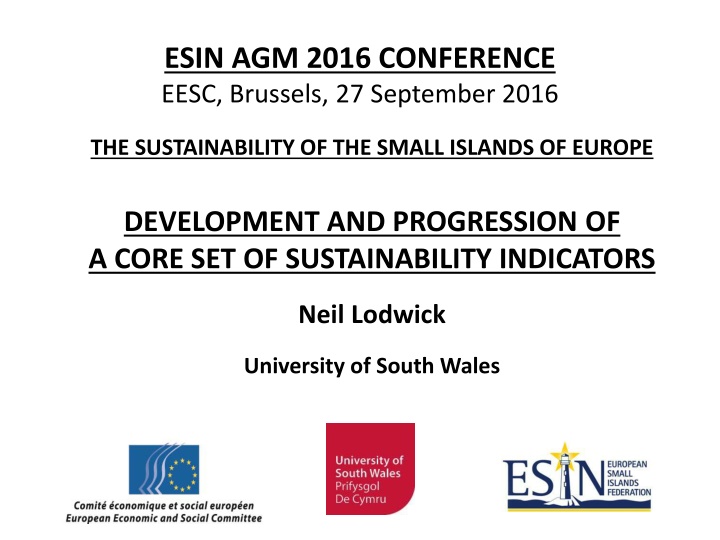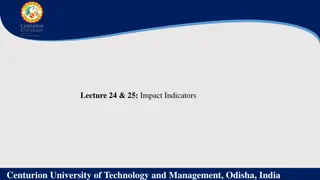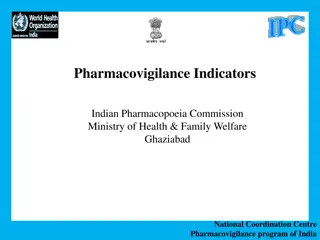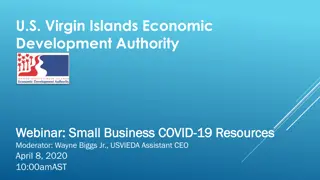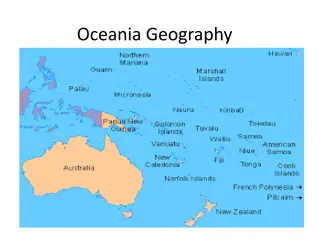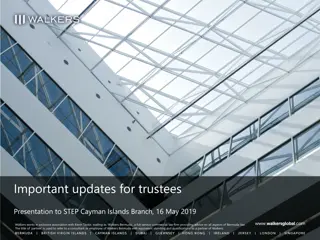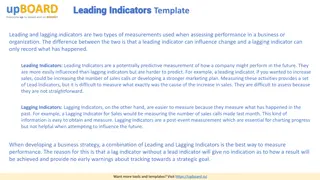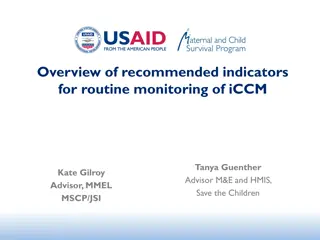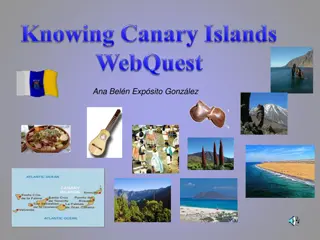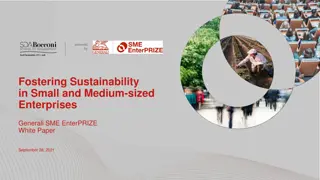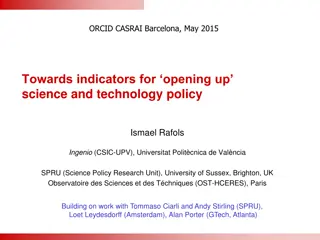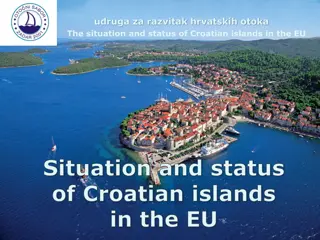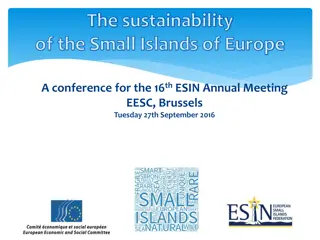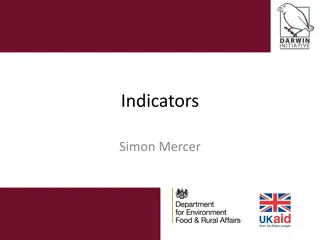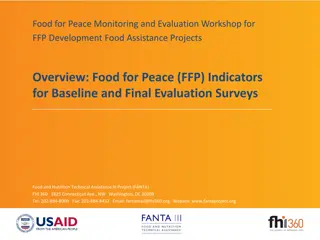Sustainability Indicators for Small European Islands
This content discusses the importance of sustainability indicators for small islands in Europe, focusing on the development and progression of a core set of indicators. It explores the challenges faced by island communities, the purpose and management of sustainability indicators, and the collaborative efforts needed for effective policy submission. The presentation emphasizes the need for discipline in maintaining and evaluating sustainability indicators to support evidence-based decision-making.
Download Presentation

Please find below an Image/Link to download the presentation.
The content on the website is provided AS IS for your information and personal use only. It may not be sold, licensed, or shared on other websites without obtaining consent from the author.If you encounter any issues during the download, it is possible that the publisher has removed the file from their server.
You are allowed to download the files provided on this website for personal or commercial use, subject to the condition that they are used lawfully. All files are the property of their respective owners.
The content on the website is provided AS IS for your information and personal use only. It may not be sold, licensed, or shared on other websites without obtaining consent from the author.
E N D
Presentation Transcript
ESIN AGM 2016 CONFERENCE EESC, Brussels, 27 September 2016 THE SUSTAINABILITY OF THE SMALL ISLANDS OF EUROPE DEVELOPMENT AND PROGRESSION OF A CORE SET OF SUSTAINABILITY INDICATORS Neil Lodwick University of South Wales
CONTENTS INTRODUCTION BACKGROUND AND PURPOSE HEADLINE ISLAND COMMUNITY CHALLENGES EUROPEAN SENSOR REPORT - SUSTAINABILITY IN EUROPEAN ISLANDS PURPOSE OF SUSTAINABILITY INDICATORS WHAT CONSTITUTES A GOOD SUSTAINABILITY INDICATOR CUTTING THROUGH DIFFERENT DATA-SETS OF INDICATORS PROPOSED SET OF ESIN SUSTAINABILITY INDICATORS MANAGEMENT AND ADMINISTRATION OF ESIN SUSTAINABILITY INDICATORS CONCLUDING REMARKS
INTRODUCTION, BACKGROUND AND PURPOSE Sustainability indicators key part of ESIN agenda building upon Sensor report 2007 Proposed Sustainability Indicators are meant to encapsulate all (and in particular small) islands including those not categorised under NUTS The contents of this presentation are focused on supporting and being infused into a wider Atlas of Islands documents ESIN expressing a commitment to operate in partnership with others who can proffer professional and supportive advice in advancing sustainability issues and in particular measures (EUROSTAT) All ESIN Membership to have an equal input and ownership of a final set of indicators Sustainability indicators as a source of supporting evidence in policy submission to wider European institution and decision makers Sustainability indicators require a strong element of discipline in both management and collation The avoidance of drift regular evaluation and monitoring and shared best practices
HEADLINE A community that monitors and documents the results of its actions, and regularly reflects on its progress and barriers, learns from its experience. It becomes more resilient, more capable of adapting to change, and better able to improve its efforts and sustain itself over time United Nations (2007)
ISLAND COMMUNITIES KEY CHALLENGES Key Challenges For Island Communities (especially those with a population of 1,000 inhabitants or less) 1. Challenge of being distant - example - access to mainland services, cost and expenditure 2. Challenge of being small example - migratory issues, economic development and diversification 3. Challenge of governance and jurisdiction 4. Challenge of climate change example - coastal/marine pollution, land management - A number of individual island development plans and associated policies incorporate many or if not all of the above.
2007 SENSOR REPORT (SUSTAINABILITY IN EUROPEAN ISLANDS) Focuses on sustainability issues in relation to European islands Helps to underpin Article 182 Amsterdam Treaty, the European Union Cohesion Policy and Strategies relating to regional development funding Important issues highlighted in report include:- 1. The need to recognise that there are different sustainability challenges re: cold and warm water islands (Page 19 & 27) 2. Size and population of islands dictates that there are different priorities and challenges in relation to social, economic, governance and environmental sustainability 3. The need to develop comparable data-sets and sustainability issues which may be used to inform policy decisions at E.U. Level . 4. 16 sustainability indicators selected-now fit for purpose or requiring closer scrutiny and definition?
PURPOSE OF SUSTAINABILITY INDICATORS Early warning signals change analysis To identify weaknesses and strengths Supporting and influencing future decision making process Supporting evidence incorporated into strategic/policy development and application Providing public and stakeholder information
WHAT CONSTITUTES A GOOD INDICATOR Technically robust Sensitive to change, can be regularly updated Relevant, meaningful, available and understood by all Complementary direct correlation with other indicators. For example a shortage of social housing on an island may have a direct relationship with migratory trends. Levels of tourism may have a particular impact on employment opportunities and the maintenance of an islands environment Comparability measuring like with like
A PLETHORA OF SUSTAINABILITY INDICATORS Current/future development of ESIN sustainability indicators what is the fit ? Avoiding repetition and confusion. A need to be mindful of other data-sets which are in operation such as: National/regional established by national governments and specific service departments (often used for example in regional planning). Local government measuring effectiveness of local strategies and policies which may and are often directly correlated to island communities. Individual islands supporting local development planning
VERY BIG ISLAND 50k inhabitants and more BIG ISLAND 50k to 5k inhabitants MEDIUM ISLAND 5k to 1k inhabitants SMALL ISLAND 1k to 50 inhabitants or less SMALL ISLANDS 50 and less than 5 WARM WATER ISLANDS COLD WATER ISLANDS SUSTAINABILITY INDICATOR SOCIAL Annual population change migratory growth/reduction % of population over 65 % island homes with internet/broadband connections Annual percentage of island students progressing to further education Access to Island emergency/health care provision % stock of social housing available for island residents % of islands residents speaking alternative language to the majority of each state s population * *European Commission and its report on lesser used languages (2002) Minority languages in many islands are part of the social capital fabric of community life and its interlinkage with island sustainability
VERY BIG ISLAND 50k inhabitants and more BIG ISLAND 50k to 5k inhabitants MEDIUM ISLAND 5k to 1k inhabitants SMALL ISLAND 1k to 50 inhabitants or less SMALL ISLANDS 50 and less than 5 WARM WATER ISLANDS COLD WATER ISLANDS SUSTAINABILITY INDICATOR GOVERNANCE Number of island residents who vote in National/local elections Establishment of an individual island local development plan in conjunction with all residents ECONOMIC Sector type employment Unemployment rates Annual total of tourists to an island Number of social enterprises on Island % of island population employed in o agriculture/farming o fishing industry
VERY BIG ISLAND 50k inhabitants and More BIG ISLAND 50k to 5k inhabitants MEDIUM ISLAND 5k to 1k inhabitants SMALL ISLAND 1k to 50 inhabitants or less SMALL ISLANDS 50 and less than 5 WARM WATER ISLANDS COLD WATER ISLANDS SUSTAINABILITY INDICATOR ENVIRONMENTAL coastline and fishing o European blue flag status/bathing waters directive Annual island precipitation rate % of land sustainably managed by Natura 2000 % of island residences served by island renewable energy resourced % of island sewage treated Domestic water quality
MANAGING AND ADMINISTERING ESIN SUSTAINABILITY INDICATORS Who oversees and coordinates the process? Identifying the role of Island Federations for example data supply Reporting procedures and communications What about other stakeholders and their roles and expertise? Explaining in detail what are the key components of each agreed indicator
CONCLUSIONS The proposed list of island sustainability indicators as outlined in Appendix A have been designed to:- Add maturity to those initially established in Sensor Report 2007 Are under the ownership of ESIN and are open to regular monitoring, evaluation and challenge. Sit alongside and reinforce the seven key principles enshrined in the European Commissions 2020 Strategy and the 2021-2029 EU programme They can act as objective evidence in the application of European Commission support as well as influencing future strategy and policy which directly effects island communities. Questions and Observations
